Physical Address
304 North Cardinal St.
Dorchester Center, MA 02124
Injection rhinoplasty is not a new concept. Beauticians and unlicensed practitioners have been injecting paraffin, silicone oil, cooking oil, and other permanent “filler” materials into the nose for decades, especially in Asia, where the desire to augment the nose is high. 1 This has led to a slew of foreign body complications that included abnormal swelling, migration, granulomas, infection, and even cavernous sinus thrombosis. In time, many of these patients developed a similar dysmorphic facies with a bloated elephantine nose. Removal of the impregnated permanent material with a restoration to a normal nasal contour is extremely challenging.
Since the 1990s, fat and a variety of newer fillers have been used for injection rhinoplasty. The newer range of synthetic fillers started first with collagen (Zyplast), then progressed to a variety of cross- or non-cross-linked hyaluronic acid (HA) fillers, calcium hydroxyapatite, and other fillers containing different substances. These have typically been injected into the nose using sharp needles or blunt cannulae by physicians of all levels, having the perception that this is a simple, straightforward procedure. As a result it has become one of the most popular injectable techniques for correcting underprojected Asian noses or Caucasian noses, which may have irregularities or mild contour problems.
Injection rhinoplasty is a procedure that carries catastrophic albeit extremely rare complication. In fact, injection rhinoplasty, together with injections of the glabellar frown lines, temples, and forehead, is now considered to be the anatomical regions with the highest vascular risks, fraught with inherently disastrous potential complications that include skin necrosis, blindness, and strokes. In the last 10, years there have been countless cases of skin necrosis, over 200 cases of blindness have been reported in the literature, and more than 40 patients have suffered strokes. The true number of unreported cases could be much higher.
In all cases of blindness, the visual loss was permanent despite any remedial measures being implemented. Of these cases, approximately half were due to fat and the other half were due to a variety of synthetic injectable fillers. Surprisingly, over 75% of these complications were associated with the use of a cannula, indicating that its use may not be as safe as we once believed. It is therefore timely to review the anatomy of the nose and its immediate surroundings to understand why these complications occurred and how we can develop safe techniques for injection rhinoplasty.
Understanding nasal anatomy allows us to formulate clear strategies when performing injection rhinoplasty. In 1990, Wu described the five soft tissue layers overlying the osseocartilaginous framework of the nose, namely, the skin envelope (thicker at the tip than over the dorsum or radix), the superficial fibrofatty areolar layer, the middle fibromuscular layer, the deep areolar layer, and the periosteum or perichondrium depending on whether it is at the bony vault or the cartilaginous portion of the nose ( Fig. 22.1 A,B ).
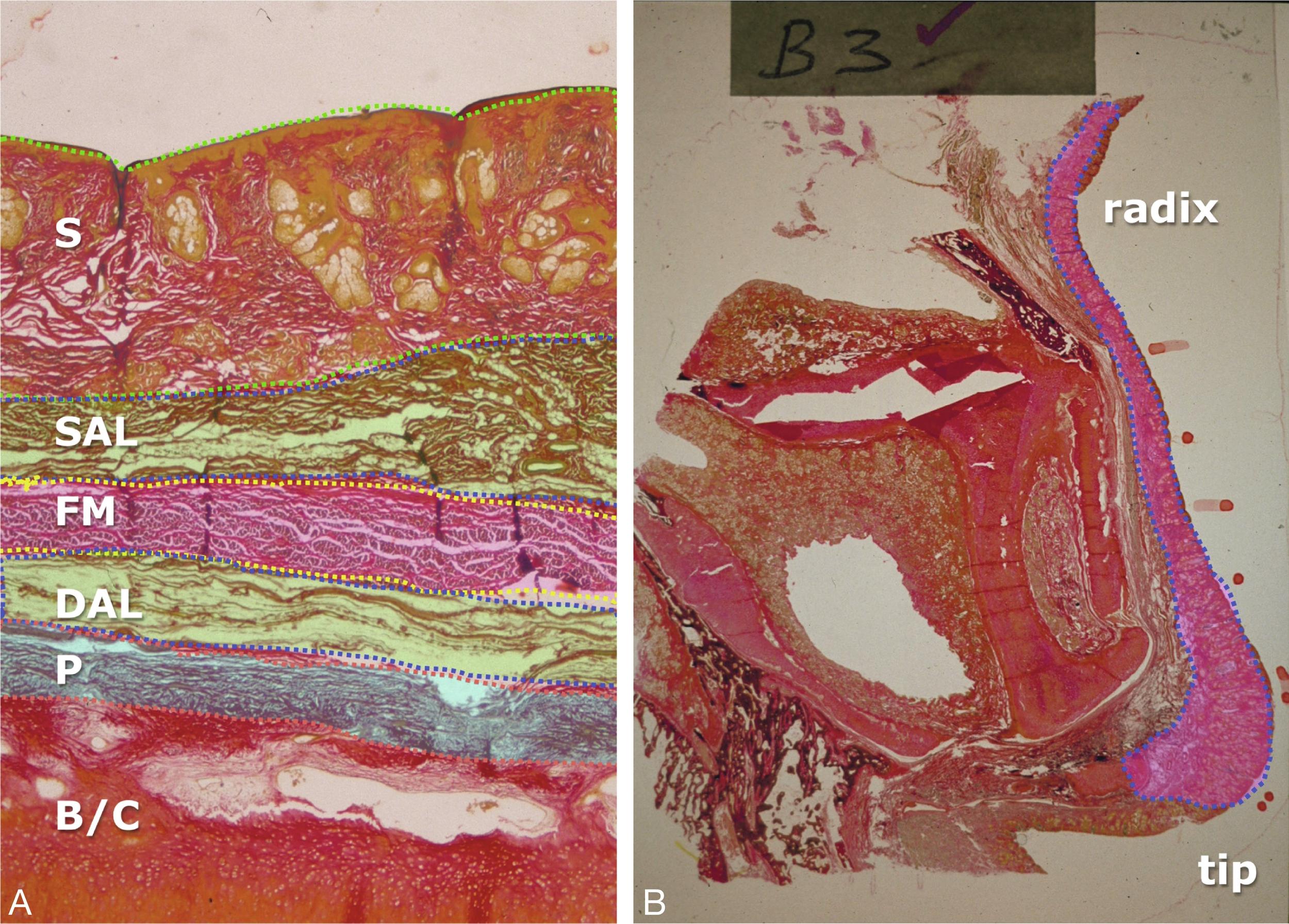
The skin of the nasal tip is thick, firm, and difficult to inject into. The periosteum and perichondrium are both tightly affixed to the underlying osseocartilaginous framework and similarly difficult to inject into or beneath. This leaves a plane of least resistance sandwiched between the outermost and innermost layers, made up of the fibromuscular layer, and the two loose areolar layers above and below it. The superficial and deep areolar layers represent two natural planes of dissection that allow the skin to be easily dissected off the fibromuscular layer ( Fig. 22.2 A ) or the fibromuscular layer from the perichicondrial/periosteal layer ( Fig. 22.2 B). The vascular network of the nose lies on the surface of this fibromuscular layer, with very few vascular branches beneath it ( Fig 22.3 A,B ). Over the alar lobules, all five layers are densely adherent to one another, while over the tip and dorsum, the skin is easily dissected free at the level of the superficial areolar (subcutaneous) layer.
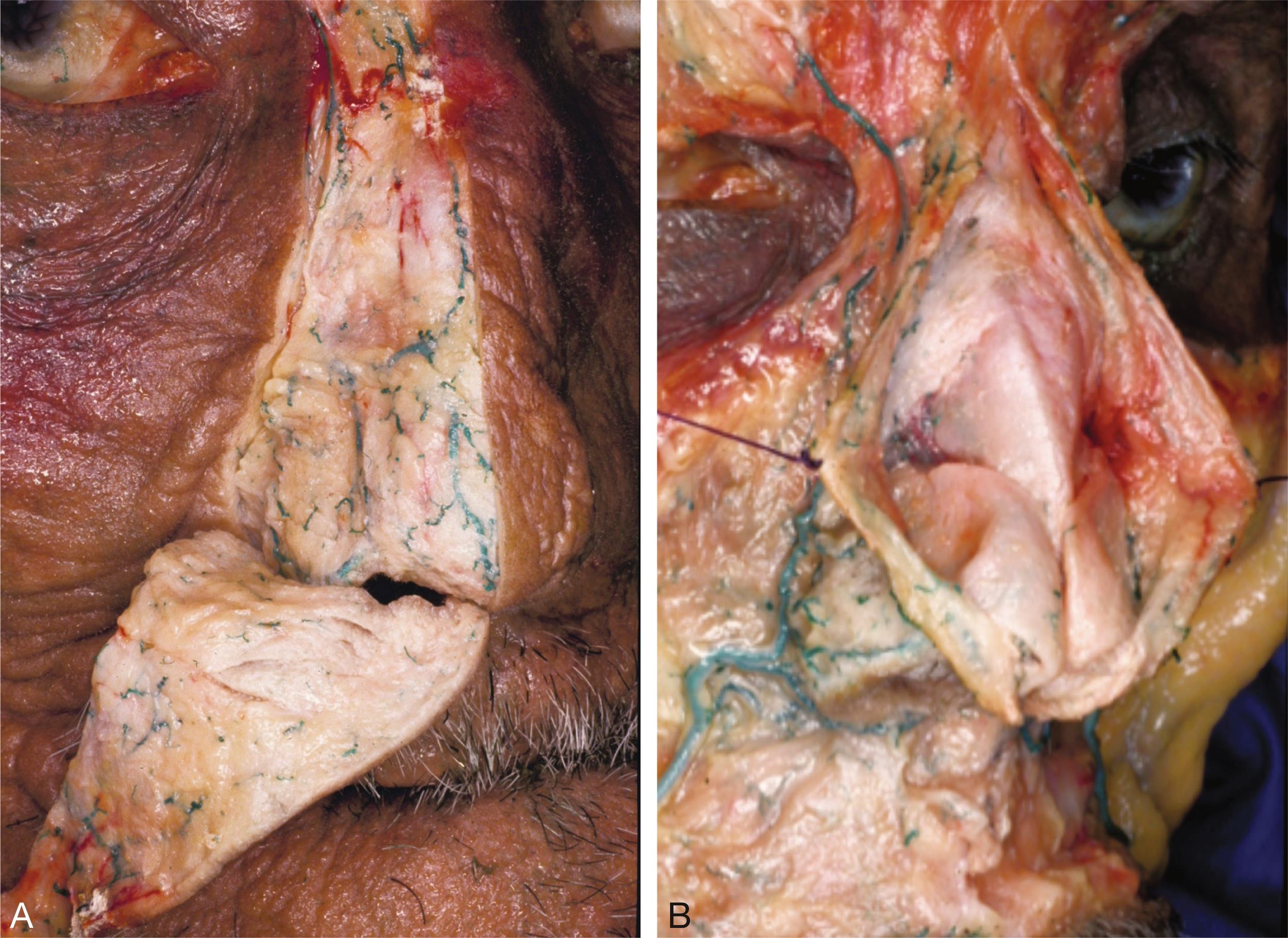
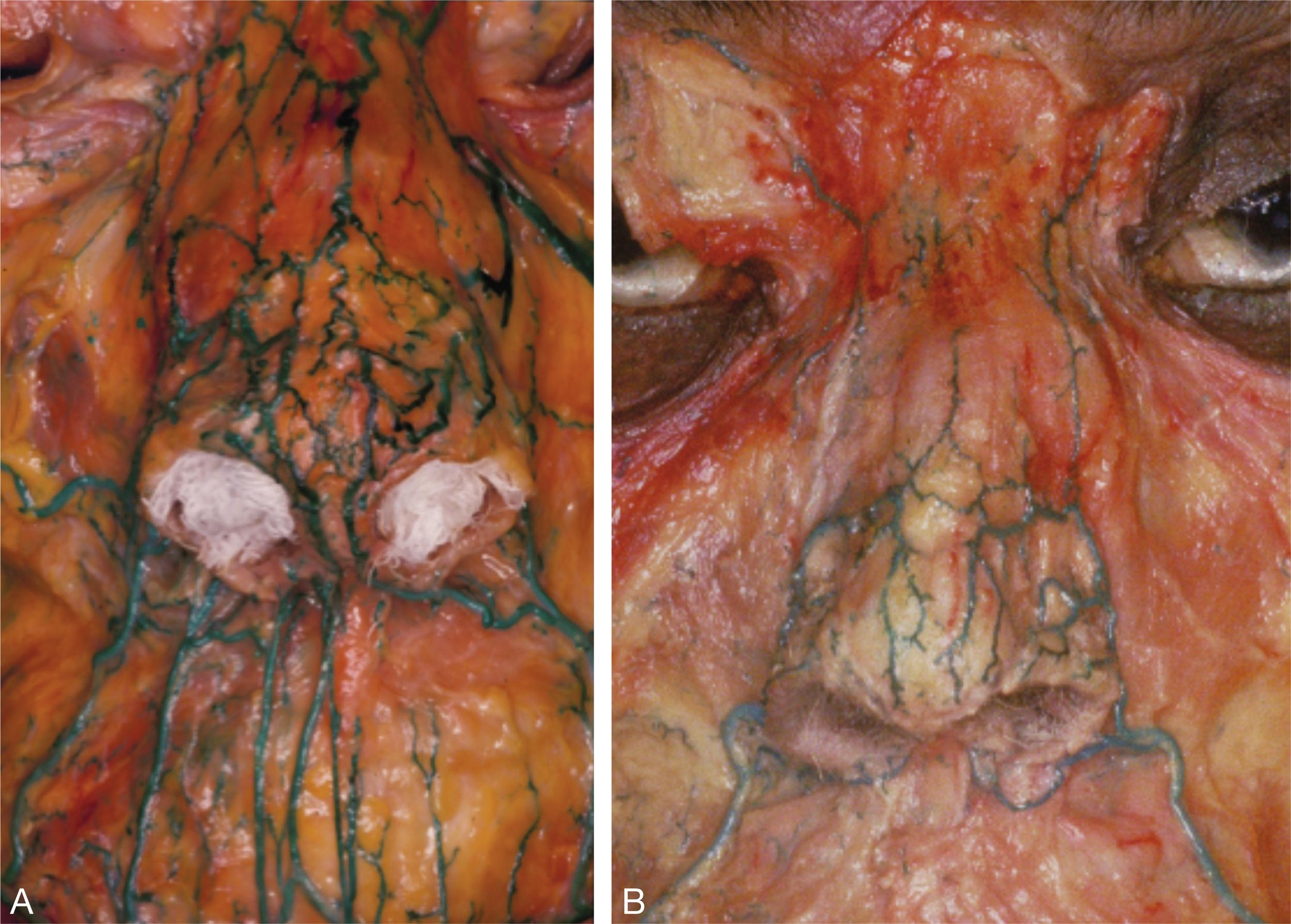
The vascular supply of the nose is derived from both the internal and external carotid artery systems, which anastomose with each other at several points in the face ( Fig. 22.4 ). This provides the anatomical basis for any filler material that is inadvertently injected into the facial artery, superficial temporal artery, or a nasal blood vessel to be propelled retrogradely into the orbit through these anastomotic channels and thereby occlude the ophthalmic artery, causing visual compromise, or even a stroke.
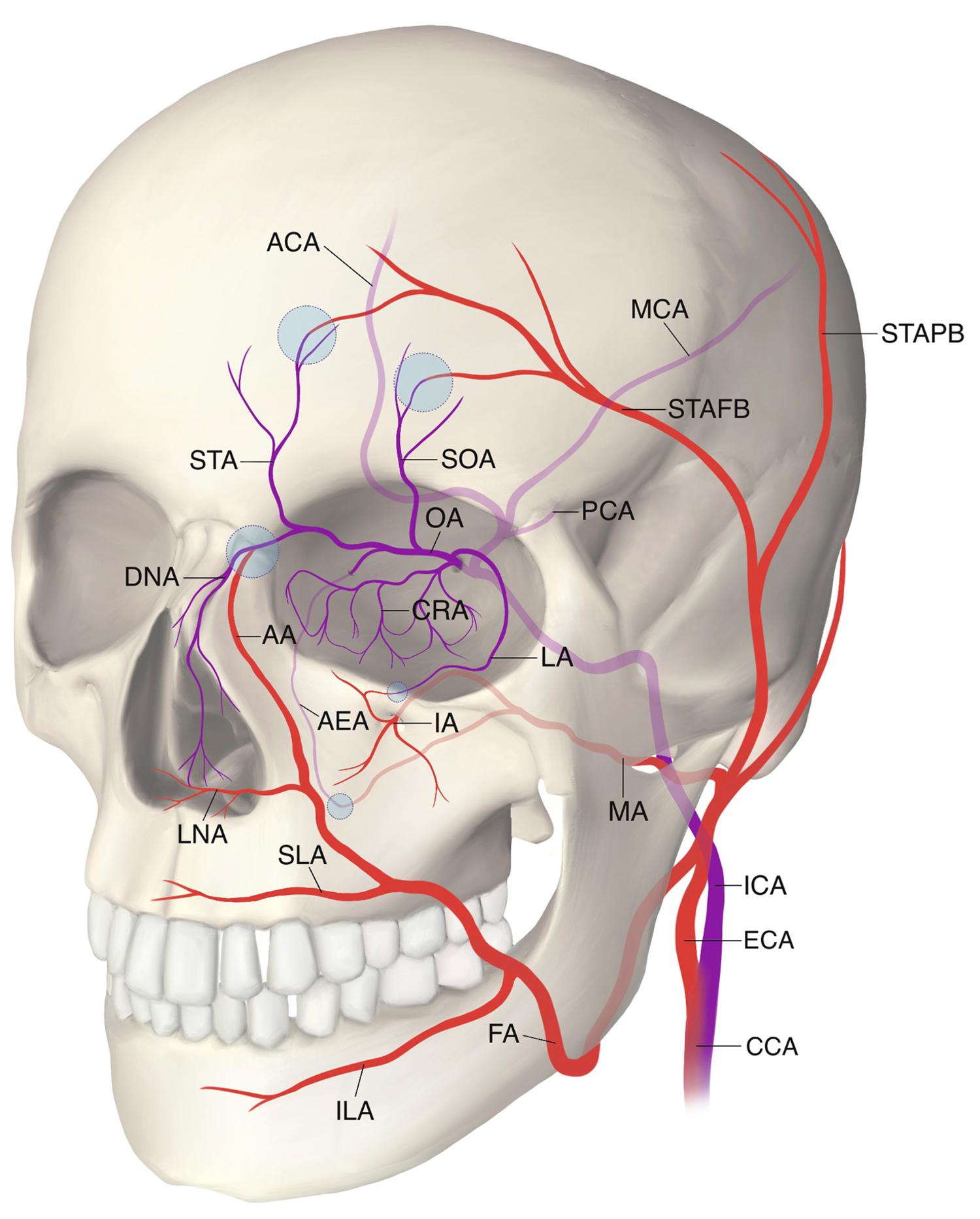
The main blood supply of the nose is derived from the columellar and alar branches of the facial artery (the external carotid system) as it winds its way upward to the medial corner of the eye to become the angular artery. These branches supply the lower two thirds of the nose. The upper third of the nose is also supplied by the dorsal nasal artery, which is a branch of the supratrochlear artery, which is itself a terminal branch of the ophthalmic artery (the internal carotid system). In a high percentage of cases, the angular artery may anastomose directly with the supratrochlear artery, thus providing a direct communication between the internal and external carotid artery systems.
In addition, the dorsal nasal, alar, and columellar arteries of each side of the nose enter into a dense vascular plexus that covers the tip and soft tissue lobule of the nose. In many anatomical specimens, the alar artery can be seen communicating directly with the dorsal nasal artery. All the major blood vessels of the nose are paired symmetrically on either side of the nose with a resultant watershed running down the midline from the glabellar down to the anterior nasal spine ( Fig. 22.3 ).
It would therefore appear that the safest way to deliver an injection of filler material to the nose is to stay in the midline and inject directly “on the bone” or dorsum of the cartilaginous septum, therefore avoiding any of the major blood vessels that mostly lie on the surface of the fibromuscular layer. For this reason, the use of a sharp 27 or 30 G needle for all injections on the nose may be safest as the needle tip can target the periosteal layer and bone most accurately and the droplet size can be kept small and well controlled. “On the bone” does not imply that the filler is actually subperiosteal and on the bone because that is a physical impossibility. But consciously touching the bony surface with the needle tip does ensure that the delivery of the filler droplet is as deep as possible and hopefully away from the major blood vessels. At the time of injection, the needle tip should remain in contact with the “bone.”
Cannulae for nasal injection have traditionally been thought to be the safer alternative of delivering filler just like the rest of the face. However, this has proven not to be the case, with majority of reported vascular complication in the nose being associated with cannula usage. The cannulas have a tendency to enter into the first plane of least resistance, this being the superficial areolar tissue plane. With the cannula aims toward the deeper layer, it will glide in the middle plane of the superficial muscular aponeurotic system (SMAS), which unfortunately is where the major blood vessels are located. This may explain why most cases of blindness have been associated with the use of cannulae and not needles. Cannulae have been postulated to penetrate the vessel at the fork of a bifurcation where it is most stationery. Larger-bore cannulae may be intuitively safer but may cause more discomfort and the entry point can leave a visible mark on the nose.
We are aware of an anecdotal case of blindness 29 following retrograde injections of a HA filler using a 21 G cannula inserted from the tip of the nose over the dorsum to the glabellar region. The surgeon noticed periorbital blanching, almost immediately after which the patient complained of blurring of vision. Despite emergency cannulation of the supraorbital and supratrochlear arteries and infiltration of hyaluronidase, the patient became blind in one eye. This an awful complication.
Injection rhinoplasty is indicated in patients who wish to have cosmetic enhancement of the nose without surgery. Younger patients are more concerned with correcting any perceived structural deficiencies and usually request significant changes to the shapes of their noses. Older patients on the other hand are more appreciative of the rejuvenative effects that result from volumizing the root and bridge of the nose or uplifting a drooping tip. Ethnic considerations play a significant role in the choice of fillers.
Asian noses tend to be broad and flat with a low dorsum, a fleshy bulbous tip, and widely spread alar lobules. The common indications for injection rhinoplasty for this group of patients are to increase the dorsal height, nasal tip projection, and elongation of the nasal tip with overall aim of increasing the three-dimensional definition of the nose as well as a “slimming effect” of the nasal shape. Such noses require fillers with a high cohesivity to resist the contracting forces of the tight, thick overlying skin envelope to elevate the bridge, project the tip of the nose anteriorly, or elongate the nose inferiorly. A small amount of filler placed lateral to the upper portion of the nasolabial fold can also displace the alar lobules medially, giving the impression of a narrower nasal base ( Figs. 22.5 A–D and 22.6 A–F ).
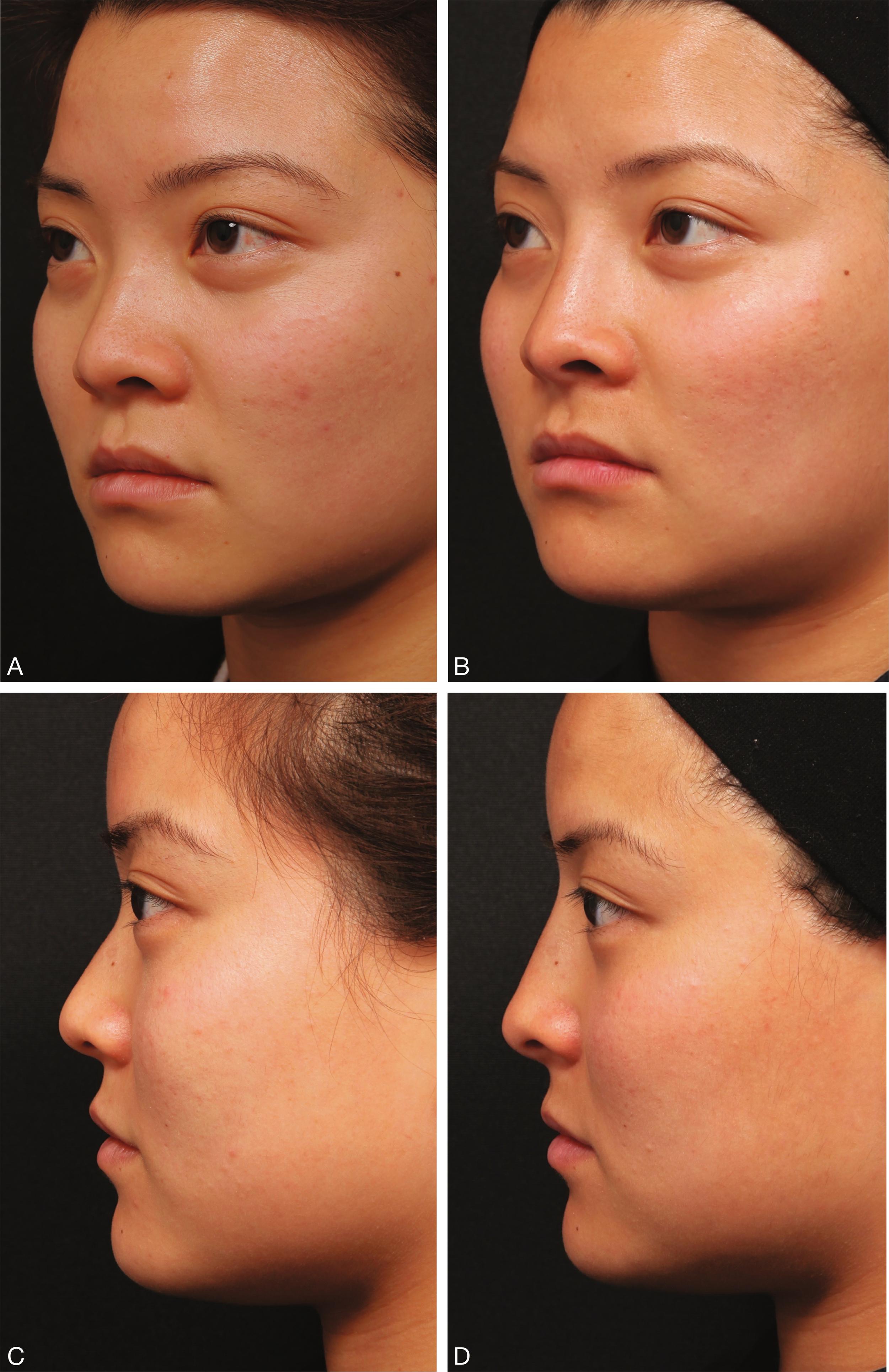
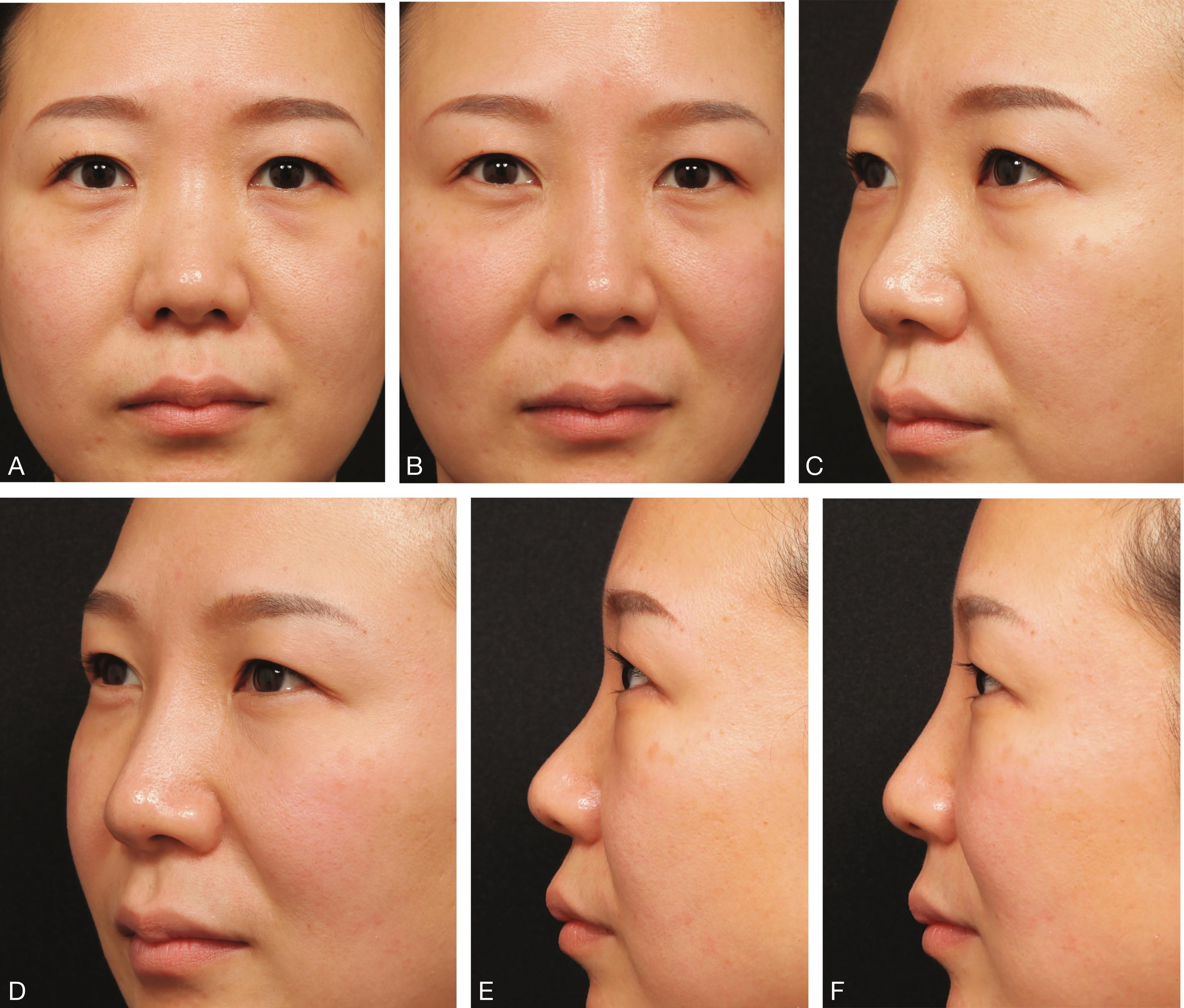
Caucasian noses usually have sufficient dorsal height, better projection, and definition of the tip due to the thinner skin envelope but may suffer from a dorsal hump, a narrow nasal bridge with an acute orbitonasal line, or a plunging tip. The common indication for this group is to correct some dorsal irregularities with a straighter dorsal and frontonasal profile, dorsal rotation of the nasal tip, and widening of the dorsal root of the nose. Fillers with a high cohesivity are desirable to provide structural support where it is needed, but fillers with a softer cohesivity can smoothen out surface or contour irregularities better. Patients with less-than-ideal results following surgical rhinoplasty can benefit from judicious and careful use of filler to smooth out any dorsal irregularities, camouflage some visible cartilage graft and correct excessive ski jump appearance ( Fig. 22.7 A–D ). Plunging tips can be elevated by providing support at the anterior nasal spine and the columella. Treating any patients who had previous surgery or accident to the nose requires special skills and knowledge for it has an even higher risk of vascular complication than normal due to altered vascular anatomy and scar tissue. It is best reserved for those who operate in the area or those who have enough expertise in treating this area.
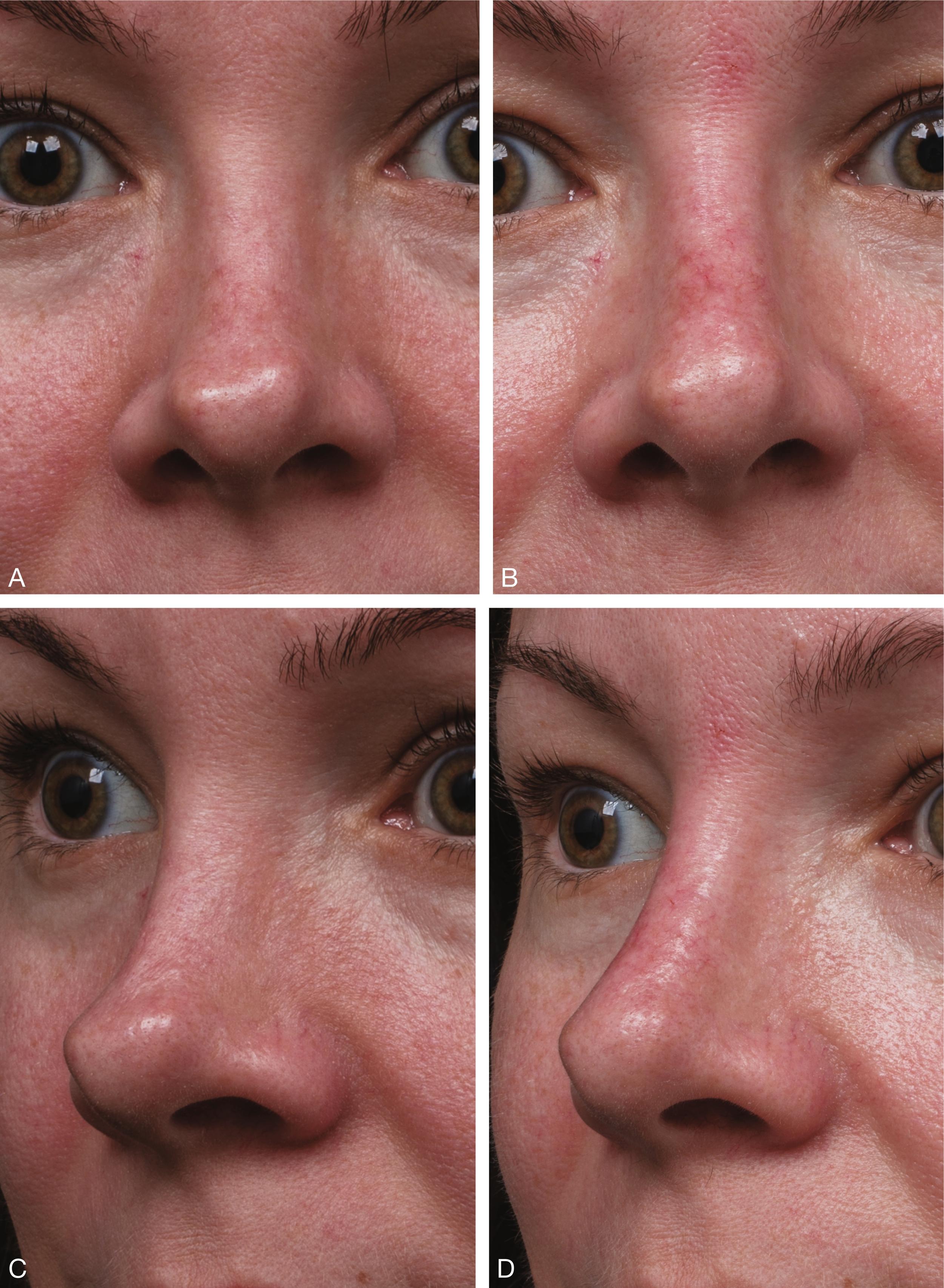
In the past, fillers were used only to augment the nasal dorsum, but today, with a variety of fillers having different degrees of cohesivity available, we are able to achieve better sculpting and shaping of the tip, columella, and base of the nose as well. The aesthetic considerations for injection rhinoplasty should be no different from performing a surgical augmentation rhinoplasty, with the fillers taking the place of either the implant or any cartilage grafts. In some cases, such as blending the dorsal aesthetic line with the medial end of the brow (the orbitonasal line), a filler can be more useful than an implant alone as it creates an aesthetically smoother and curved transition between the side of the nose and the medial end of the eyebrow. Implants on their own may actually aggravate the vertical glabellar furrows with a groove unesthetically breaking up the continuous orbitonasal line.
Become a Clinical Tree membership for Full access and enjoy Unlimited articles
If you are a member. Log in here